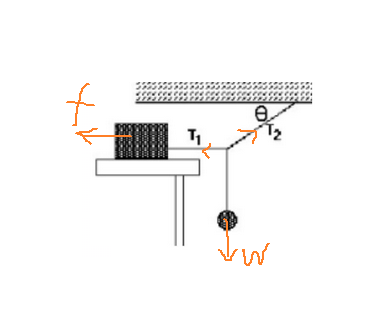Find T₁ The hanging sphere off the table has a mass of 2.98 kg. The string makes a 27.1° angle to the ceiling. How much does the sphere weigh? Find T₂ T₁ N N 8. N N The block on the table does not move. How much friction must be acting between the table and the block?
Find T₁ The hanging sphere off the table has a mass of 2.98 kg. The string makes a 27.1° angle to the ceiling. How much does the sphere weigh? Find T₂ T₁ N N 8. N N The block on the table does not move. How much friction must be acting between the table and the block?
College Physics
11th Edition
ISBN:9781305952300
Author:Raymond A. Serway, Chris Vuille
Publisher:Raymond A. Serway, Chris Vuille
Chapter1: Units, Trigonometry. And Vectors
Section: Chapter Questions
Problem 1CQ: Estimate the order of magnitude of the length, in meters, of each of the following; (a) a mouse, (b)...
Related questions
Topic Video
Question
100%
![### Problem Analysis
**Diagram Description:**
The diagram features a frictionless pulley system with a mass hanging off a table. There is a string connected to the mass (sphere), making an angle of 27.1° with the ceiling. There are two tension forces indicated: \( T_1 \) acting along the horizontal part of the string on the table, and \( T_2 \) acting along the string that makes an angle with the ceiling.
**Questions:**
1. **The hanging sphere off the table has a mass of 2.98 kg. The string makes a 27.1° angle to the ceiling.**
- **How much does the sphere weigh?**
\[ \_\_\_\_ \, \text{N} \]
- **Find \( T_1 \)**
\[ \_\_\_\_ \, \text{N} \]
- **Find \( T_2 \)**
\[ \_\_\_\_ \, \text{N} \]
2. **The block on the table does not move. How much friction must be acting between the table and the block?**
\[ \_\_\_\_ \, \text{N} \]
### Explanation:
- **Weight of the Sphere:**
The weight of the sphere (\( W \)) is calculated using the formula \( W = mg \), where \( m \) is the mass of the sphere and \( g \) is the acceleration due to gravity (approximately \( 9.81 \, \text{m/s}^2 \)).
- **Tension in the String:**
\( T_1 \) and \( T_2 \) represent the tensions in the string. Using trigonometry and the fact that the system is in equilibrium, you can set up equations to solve for these tensions. The angle of 27.1° will be useful in resolving components of the tensions.
- **Frictional Force:**
The frictional force (\( f \)) can be determined once the horizontal component of the tension is known (\( T_1 \)), as this must be equal to the frictional force since the block does not move.](/v2/_next/image?url=https%3A%2F%2Fcontent.bartleby.com%2Fqna-images%2Fquestion%2F29bc6eb3-7a22-4e16-a2f0-f6b588d627c8%2Ffd8bd2ee-7f54-4230-b603-39fe44c39a3e%2Fmh00jhk_processed.png&w=3840&q=75)
Transcribed Image Text:### Problem Analysis
**Diagram Description:**
The diagram features a frictionless pulley system with a mass hanging off a table. There is a string connected to the mass (sphere), making an angle of 27.1° with the ceiling. There are two tension forces indicated: \( T_1 \) acting along the horizontal part of the string on the table, and \( T_2 \) acting along the string that makes an angle with the ceiling.
**Questions:**
1. **The hanging sphere off the table has a mass of 2.98 kg. The string makes a 27.1° angle to the ceiling.**
- **How much does the sphere weigh?**
\[ \_\_\_\_ \, \text{N} \]
- **Find \( T_1 \)**
\[ \_\_\_\_ \, \text{N} \]
- **Find \( T_2 \)**
\[ \_\_\_\_ \, \text{N} \]
2. **The block on the table does not move. How much friction must be acting between the table and the block?**
\[ \_\_\_\_ \, \text{N} \]
### Explanation:
- **Weight of the Sphere:**
The weight of the sphere (\( W \)) is calculated using the formula \( W = mg \), where \( m \) is the mass of the sphere and \( g \) is the acceleration due to gravity (approximately \( 9.81 \, \text{m/s}^2 \)).
- **Tension in the String:**
\( T_1 \) and \( T_2 \) represent the tensions in the string. Using trigonometry and the fact that the system is in equilibrium, you can set up equations to solve for these tensions. The angle of 27.1° will be useful in resolving components of the tensions.
- **Frictional Force:**
The frictional force (\( f \)) can be determined once the horizontal component of the tension is known (\( T_1 \)), as this must be equal to the frictional force since the block does not move.
Expert Solution
Step 1

Visualize the Problem:

Step by step
Solved in 2 steps with 3 images

Follow-up Questions
Read through expert solutions to related follow-up questions below.
Follow-up Question
So when I tried to apply these answers my professor said ALL are wrong? Am I missing something?
Solution
Knowledge Booster
Learn more about
Need a deep-dive on the concept behind this application? Look no further. Learn more about this topic, physics and related others by exploring similar questions and additional content below.Recommended textbooks for you

College Physics
Physics
ISBN:
9781305952300
Author:
Raymond A. Serway, Chris Vuille
Publisher:
Cengage Learning

University Physics (14th Edition)
Physics
ISBN:
9780133969290
Author:
Hugh D. Young, Roger A. Freedman
Publisher:
PEARSON

Introduction To Quantum Mechanics
Physics
ISBN:
9781107189638
Author:
Griffiths, David J., Schroeter, Darrell F.
Publisher:
Cambridge University Press

College Physics
Physics
ISBN:
9781305952300
Author:
Raymond A. Serway, Chris Vuille
Publisher:
Cengage Learning

University Physics (14th Edition)
Physics
ISBN:
9780133969290
Author:
Hugh D. Young, Roger A. Freedman
Publisher:
PEARSON

Introduction To Quantum Mechanics
Physics
ISBN:
9781107189638
Author:
Griffiths, David J., Schroeter, Darrell F.
Publisher:
Cambridge University Press

Physics for Scientists and Engineers
Physics
ISBN:
9781337553278
Author:
Raymond A. Serway, John W. Jewett
Publisher:
Cengage Learning

Lecture- Tutorials for Introductory Astronomy
Physics
ISBN:
9780321820464
Author:
Edward E. Prather, Tim P. Slater, Jeff P. Adams, Gina Brissenden
Publisher:
Addison-Wesley

College Physics: A Strategic Approach (4th Editio…
Physics
ISBN:
9780134609034
Author:
Randall D. Knight (Professor Emeritus), Brian Jones, Stuart Field
Publisher:
PEARSON